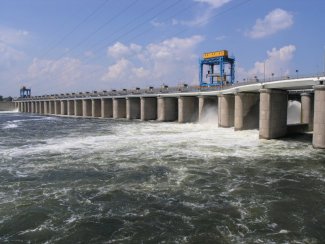The dam on the Dnieper at Nova Kakhovka has been blown up. Day 467 of the war

On the morning of 6 June, Kyiv reported that Russian troops had blown up the dam at Nova Kakhovka. The road crossing over the River Dnieper and part of the Kakhovka Hydroelectric Power Plant were destroyed, leading to an uncontrolled outflow of water from the Kakhovka Reservoir and the flooding of towns downstream on both banks of the river, including parts of Kherson city. Approximately 80 villages are in the flood zone, and the authorities have begun evacuating civilians and making efforts to bring drinking water to the area. 150 tonnes of lubricants were said to have leaked into the River Dnieper from the damaged power plant; there is a risk that a further 300 tonnes will leak. The Ukrainian energy system is operating stably. The nuclear power plant operator Enerhoatom assessed the situation around the Zaporizhzhia NPP as ‘non-critical’: it has its own reservoir for system cooling which is autonomous from the Kakhovka reservoir. However, the CHP plant in Kherson is at risk of flooding.
The Ukrainian government, with President Volodymyr Zelensky leading the way, has reacted strongly to the blowing up of the dam at Nova Kakhovka, declaring it to have been a Russian act of terror. According to Mykhailo Podolak, advisor to the head of the President’s Office, the Russian 205th Motorised Rifle Brigade (which had long been stationed in the Nova Kakhovka area) was responsible for detonating the explosives. Above all Kyiv has been emphasising the environmental consequences of the dam’s destruction, which could extend to the Black Sea basin. As they put it, the safety of the operation of the Zaporizhzhia Nuclear Power Plant could be threatened in the long term. Kyiv has announced an appeal to international institutions to hold the Russians accountable. In turn, a Kremlin spokesman rejected the Ukrainian accusations, claiming that it was the Ukrainians who had carried out the demolition, the main aim of which was allegedly to cut off Crimea’s water supply.
On 4 June, Ukrainian forces struck at Russian positions on the southern section of the front, on both sides of the town of Velyka Novosilka, from where the shortest route to occupied Mariupol leads. They had some short-term success, taking the village of Novodarivka in Zaporizhzhia oblast, and also (according to some sources) Neskuchne in Donetsk oblast. The Russians apparently regained the lost villages in a counter-attack, but failed to push the Ukrainian units all the way back to their earlier positions. The following day, the Ukrainians renewed their assault, pushing the invaders out of the village of Novodonetske in Donetsk oblast. After fighting lasting several hours, Russian forces regained control of this locality as well, but the defenders held onto their gains north of it. On 5 June, Ukrainian units also struck in the north-eastern part of Donetsk oblast, attacking in the area of Horlivka, Soledar and Bakhmut, achieving minor success north-west of the latter town (near Berkhivka).
The Ukrainian command denies that it has launched offensive operations at the interface between Donetsk and Zaporizhzhia oblasts, and has describes reports (especially those from the Russian defence ministry) that it has launched the counter-offensive as deliberate disinformation. Nevertheless, the clashes were reported by Ukrainian local sources, civilian and military, boasting of the successes achieved. In the attacks in the Velyka Novosilka area, the Ukrainians engaged battalion-level units, including some prepared and equipped by the West, which had been part of brigades hitherto kept in reserve. For the first time, the use in combat of some of the heavy weaponry acquired in recent months (including Leopard 2 tanks) was confirmed. In contrast to the situation in the south, which Kyiv has kept under wraps, the deputy defence minister Hanna Malar and the commander of the Land Forces General Oleksandr Syrskyi publicised the transition to offensive operations in the Bakhmut area, reporting the successes Ukrainian forces have had there. According to Malar, Ukrainian forces penetrated the enemy grouping south-west of the town to a depth of between 100 and 700 metres, and to a depth of between 200 and 1600 metres in the area of the M03 highway to Slovyansk north-west of the town. According to communiqués from the Ukrainian General Staff, the Russians are also attacking west of Bakhmut, but their activity remains low (five clashes took place around the town on 3 June and one on 4 June).
The invading forces have succeeded in pushing the defenders out of more quarters of Marinka, and are now in control of around 80% of the town’s area. The Russian attacks intensified after the Chechen spetsnaz unit Akhmat was sent to Marinka. The situation northeast of Kupiansk remains unclear, where according to some sources, the invaders have gained bridgeheads on the western side of the Oskil river. However, further Russian attacks on the border of Kharkiv & Luhansk and Luhansk & Donetsk oblasts appear to have failed. A significant drop in military activity has been reported in the Avdiivka area. According to the Ukrainian General Staff, the total number of clashes in all directions has begun to rise again; however, their communiqués did not take the fighting on the southern section of the front (in Ukrainian nomenclature, the Shakhtar and Zaporizhzhia directions) into account, so the total number may be much higher.
The Russians have continued their attacks on Kyiv and Kyiv oblast using kamikaze missiles and drones. As is customary, the local military administration declared that all the attacking objects were shot down, and linked any recorded damage to falling debris. The Ukrainian Air Force Command confirmed that Russian cruise missiles hit an airfield near Kropyvnytskyi on 4 June. Russian missiles also fell in Kharkiv (5 June) and elsewhere in Kharkiv oblast, Slavyansk and the suburbs of Dnipro city, where the impact killed one civilian and wounded 22. According to the Ukrainian General Staff, on 4 June the Russian launched 14 missiles (the defenders claimed to have shot down four out of six Kh-101/Kh-555 cruise missiles) and eight Shahed-136/131 kamikaze drones (six of which were shot down). In contrast, on 6 June, the Air Force Command reported that all 35 Kh-101/Kh-555 cruise missiles had been shot down.
The night of 5 June saw a massive shelling of Kherson with MLRS fire. Russian artillery and aviation also intensified their attacks on Nikopol, Ochakiv and the border areas of Sumy oblast. Between 2 and 4 June, the Ukrainians attacked Berdyansk (the port was targeted on 2 June) and Melitopol twice. In turn, on 4 and 5 June, the Russian side reported Ukrainian drone activity in the town of Dzhankoi in Crimea and in Belgorod oblast, where an energy facility was targeted.
On 2 June, DPA reported that the German government had concluded a contract with Flensburger Fahrzeugbau GmbH (FFG) to supply 66 wheeled armoured personnel carriers to the Ukrainian army. These are most likely to be Fuchs transporters withdrawn from service in the Bundeswehr. FFG will also hand over Swedish trucks previously used by the German army.
On 2 June, the Ukrainian president ordered an audit of publicly accessible shelters and places to hide from air attacks. Zelensky’s decision came in response to the deaths of three people in Kyiv who were unable to access a shelter because the entrance was closed. On 5 June, the interior ministry reported that local authorities had inspected 50,195 shelters across the country: they found that 4679 (9%) were closed and 11,644 (23%) were unusable. In Kyiv, of the 2156 shelters inspected, 137 (6%) were found to be closed and 804 (37%) were not fit for use. The Minister of strategic industries Oleksandr Kamyshyn admitted that the situation with shelters in Kyiv is critical. The disclosure of these shortcomings has triggered a wave of criticism levelled against Kyiv’s mayor Vitali Klitschko.
The psychological and sabotage actions in Belgorod oblast are ongoing. Russian volunteer troops are operating in the area of the border village of Novaya Tavolzhanka: they claim that its population was evacuated in advance, and that they have not encountered any resistance by Russian forces. Referring to the information about support provided by Polish volunteers, the Russian Volunteer Corps assured that no Polish group is operating on the territory of the Russian Federation, or is involved in logistics or the supervision of captured prisoners. As part of a psychological operation, the volunteers proposed evacuating the inhabitants of Belgorod oblasts to Ukraine, guaranteeing that a so-called humanitarian corridor would be opened up for them. This is to protect the local population from Russian shelling of the border areas. Another attempt to influence Russian public opinion came in the form of a disinformation operation carried out on 5 June in Rostov, Belgorod and Voronezh oblasts: Ukrainians briefly took over the frequencies of local TV and radio stations and broadcast a faked ‘appeal’ by Vladimir Putin in which he called on Russians to evacuate inland because of the invasion of the Ukrainian army, and announced a general mobilisation. A representative of Ukrainian military intelligence expressed the opinion that the actions of ‘Russian rebels’ would intensify. He indicated that the Russian authorities could not control the situation, which would add to the sense of chaos and increase criticism of the local authorities.
Commentary
- The destruction of the dam came as Ukrainian offensive operations on many sections of the front were intensifying. The invaders had long been reckoning with the possibility of a Ukrainian landing across the Dnieper near Kherson and Nova Kakhovka. An artificially induced flood could delay the Ukrainian initiative on this section of the front. At the same time, however, it will destroy the lines of fortifications the Russians have built up in recent months, and create a problem for supplies of drinking water to localities in areas controlled by both Ukrainians and Russians, including occupied Crimea. Since last spring, control of the dam has been maintained by Russian troops, who have taken no remedial action despite the physical damage to the facility: it was most likely they who placed the explosives in the dam.
- Kyiv denied reports of fighting on the southern section of the frontline. However, the nature of the actions taken and the means used indicate that on 4 June Ukrainian forces embarked on an operation to break through Russian positions around Mariupol. The importance of this phase of the fighting is evidenced not only by the scale of the forces and resources the Ukrainians have committed (especially the use of brigades that had been prepared for many months, trained and equipped in the West with a view to the future counter-offensive), but also by their activation in the north-east of Donetsk oblast. This latter move should be regarded as ancillary, intended to divert attention from the strike in the south. This is evidenced by the dispersion of the effort and the much smaller scale of engagement than that on the border of Zaporizhzhia and Donetsk oblasts, and by the publicity the Ukrainian command has given to the other offensive activities it has launched (especially in the area of Bakhmut). Maintaining an embargo on reporting on the fighting in the south allows the Ukrainians to shape the information message freely. If the attacks being undertaken lead to a breakthrough of Russian positions and success in and around the towns on the Azov Sea, Kyiv will be able to officially confirm that the long-heralded counter-offensive has indeed begun.





